|
|
|
Sort Order |
|
|
|
Items / Page
|
|
|
|
|
|
|
| Srl | Item |
| 1 |
ID:
131480
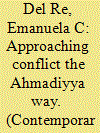

|
|
|
|
|
| Publication |
2014.
|
| Summary/Abstract |
The role and incidence of the Ahmadiya community in Israeli society, with its around 2,000 members, is not related to the dimension of the community, its religious activities or its dissemination on the territory. It is related to the strong social and political engagement of the community not only in religious but also in civil society activities where it resides, despite all the difficulties that derive from its disputed role in Islam. The Ahmadiyya community in Haifa constitutes a relevant example of contribution to peaceful and productive coexistence. Haifa itself is characterized by a very interesting social and political climate, by which it is considered a "model" of coexistence in Israel, despite the fact that many contrasts and contradictions persist, such as forms of discrimination and inequalities. The civil society is particularly active, and institutions and NGOs devoted to the Arab-Jewish dialogue are many. Religious and political leaders communicate and participate together in various events, where their openness and mutual respect are intended to symbolize harmony with the intent of this being mirrored by the whole society. The Ahmadiyya Community plays an active role in this evolving process. The author, who has carried out qualitative research in Haifa to film a scientific documentary on the Holiday of Holidays and the validity of the Haifa model of coexistence, applied participant observation in the framework of grounded theory to analyze the role and impact of the Ahmadiyya community in the complex Israeli context, also on the basis of extensive in depth interviews with community members and leaders
|
|
|
|
|
|
|
|
|
|
|
|
|
|
|
|
| 2 |
ID:
129803


|
|
|
|
|
| Publication |
2014.
|
| Summary/Abstract |
Looking primarily at the Israeli side of the conflict, one sees many factors that have contributed to the failure of past peace efforts, most of which may be present or repeated in current (2014) and possibly future - attempts at peace making.
|
|
|
|
|
|
|
|
|
|
|
|
|
|
|
|
| 3 |
ID:
131518
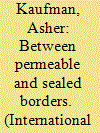

|
|
|
|
|
| Publication |
2014.
|
| Summary/Abstract |
The Trans-Arabian Pipeline (Tapline), which extended from Dhahran in Saudi Arabia to Zahrani in Lebanon and operated from 1950 to 1982, was haunted by the Arab-Israeli conflict throughout the years of its operation. The route of the pipeline-which traversed Saudi Arabia, Jordan, Syria, and Lebanon-was chosen so as to circumvent Palestine/Israel. However, following the Israeli occupation of the Golan Heights in the 1967 war, Israel became an active participant in this project, with the full consent of the transit states and Egypt. This article uses Tapline as a means to analyze the interconnected world facilitated by oil pipelines, which defies common wisdom about state sovereignty or the function of interstate boundaries. In addition, Tapline demonstrates how this interconnected network created possibilities for Arab-Israeli cooperation that might have seemed inconceivable initially, given the hostile dynamics of the conflict.
|
|
|
|
|
|
|
|
|
|
|
|
|
|
|
|
| 4 |
ID:
129799
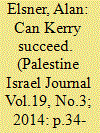

|
|
|
|
|
| Publication |
2014.
|
| Summary/Abstract |
During the many years of US Diplomacy in the Middle East, it has become a cliché to state that the United States cannot want peace more than the Israelis and Palestinians themselves.
|
|
|
|
|
|
|
|
|
|
|
|
|
|
|
|
| 5 |
ID:
129801
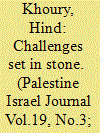

|
|
|
|
|
| Publication |
2014.
|
| Summary/Abstract |
What are the challenges to peace in 2014? The date is worth emphasizing, since attempts to broker peace in the Middle East are anything but new. In fact, the 1979 David Accords with Egypt are already 35 year old, and the Israeli-Palestinian peace process in entering its 23rd year. The process is growing stronger, but genuine peace is weakening by the day. In the meantime, there have been countless studies, articles, books, maps and reports addressing all aspects in the conflicts.
|
|
|
|
|
|
|
|
|
|
|
|
|
|
|
|
| 6 |
ID:
129798
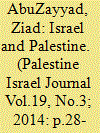

|
|
|
|
|
| Publication |
2014.
|
| Summary/Abstract |
The issue of land is at the core of the Palestinian - Israeli conflict. For a long time efforts aimed at achieving a settlement to the conflict were based on the principle of 'land for peace' meaning that if Israel withdraws from the occupied Arab territories, including the occupied Palestinian land, the Arabs will make peace with Israel.
|
|
|
|
|
|
|
|
|
|
|
|
|
|
|
|
| 7 |
ID:
132935


|
|
|
|
|
| Publication |
2014.
|
| Summary/Abstract |
This article applies ethnographic methods and historical analysis to explore Jewish-Arab relations within Israeli freemasonry. This article tracks local Masonic history as the fraternity development from individual lodges under colonial like obedience's in late Ottoman and Mandate -era Palestine into a national level organization, under the ground lodge of the state of Israel. In light of an official position of political noninvolvement, Jewish and Arab-Palestine members conveyed shared value of universal fraternity, but variable interpretation of citizenship and nationalism.
|
|
|
|
|
|
|
|
|
|
|
|
|
|
|
|
| 8 |
ID:
129850
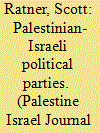

|
|
|
|
|
| Publication |
2014.
|
| Summary/Abstract |
Ever since the deterioration of the Israeli-Palestinian peace process following the outbreak of the second intifada in late 2000, it has been widely acknowledge that relations between the Israeli and Palestinian political establishments have become strained almost to the breaking point. However, far less attention has been directed to the Palestinian-Arab-Israel (PAI) parties whose transformation and pivotal role in the social and political dynamics of the conflicts should not be underestimated.
|
|
|
|
|
|
|
|
|
|
|
|
|
|
|
|
| 9 |
ID:
129837
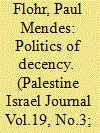

|
|
|
|
|
| Publication |
2014.
|
| Summary/Abstract |
It is said that Nelson Mandela's political vision was fundamentally "driven by a profound sense of decency." This may also be said of the Jewish philosopher Martin Buber (1878-1965). Alert to the indignities faced by his fellow human beings, he found it simply indecent to allow such injustices to continue. According, he taught that a sense of decency should inform our ethical and political judgment.
|
|
|
|
|
|
|
|
|
|
|
|
|
|
|
|
| 10 |
ID:
130411


|
|
|
|
|
| Publication |
2014.
|
| Summary/Abstract |
After Israel's first invasion of Lebanon in 1978, the UN Security Council passed Resolution 425 (UNSCR 425) establishing the United Nations Interim Force in Lebanon (UNIFIL). The early struggle over the contested meanings and interpretations of UNSCR 425, and the differences of position regarding UNIFIL itself were never fully resolved due to the shifting nature of US policies and objectives in the region and the context of the force's deployment within two distinct, albeit related conflicts: the Lebanese civil war and Arab-Israeli conflict. UNIFIL found itself trapped between the competing demands of sovereignty and resistance, not knowing which war it was there to prevent and which peace it was meant to build. This confusion resurfaced with the passage of UNSCR 1701 following the 2006 war, when UNIFIL's mandate and scope was expanded, but the force continued to be a site of contested narratives and potential future conflicts.
|
|
|
|
|
|
|
|
|
|
|
|
|
|
|
|
| 11 |
ID:
131859
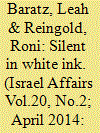

|
|
|
|
|
| Publication |
2014.
|
| Summary/Abstract |
This article seeks to reflect the narrative of discrimination in the writing of Israeli Palestinian women poets through the motif of Silence. This narrative emerges from the analysis and categorization of this motif in some 200 poems, written in Arabic and translated into Hebrew, thus revealing the poets' attitudes to social and political issues. This article shows that the poets' identity is perceived as the marginalized 'other' in Israeli society, not only in terms of nationality and ideology but also in terms of gender.
|
|
|
|
|
|
|
|
|
|
|
|
|
|
|
|
|
|
|
|
|